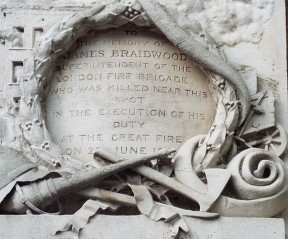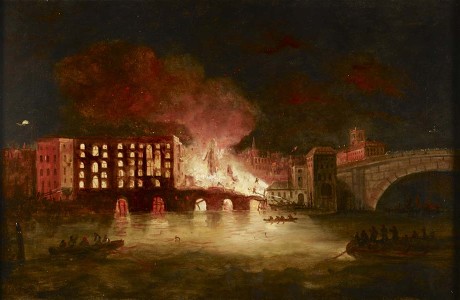





Exploring Southwark and discovering its history


The Great Fire of Tooley Street, 1861
High above Tooley Street, on the side of a building facing Cottons Lane, is a decorated plaque. It is made of marble and carved into the background is a relief of burning buildings. To the forefront is fire-fighting equipment including an axe, a helmet and a partly coiled fire hose. An inscription reads: “To the Memory of James Braidwood Superintendent of the London Fire Brigade who was killed near this spot in the Execution of his Duty at the Great Fire on 23rd June 1861.”

James Braidwood was born in Edinburgh in 1800, the son of a builder and after school joined his father’s firm as an apprentice. He learned how buildings were constructed and became particularly interested in the way that fire spread throughout a building. At this time, if a fire broke out, it was tackled by the insurance company who insured the building to minimise damage. They employed their own fire brigades but this led to a very fragmented approach where buildings that were uninsured were often left to burn. The fire-fighters received very little training and equipment was very basic.
In 1824 and only aged 24, James Braidwood worked with municipal authorities and insurance companies in Edinburgh to create the first public fire service. He used scientific methods in the fighting of fires and place great emphasis on the training of firemen. Fire-fighters now entered the burning building to deal with the fire at source. In 1833 ten insurance companies in London joined together to form the London Fire Engine Establishment and James Braidwood appointed its first Superintendent. A total of 80 firefighters were employed by the LFEE at 13 stations throughout London.
The Great Fire of Tooley Street started late afternoon on 22nd June 1861 in Cotton’s Wharf, on the riverside close to London Bridge. Smoke had been seen coming from the first floor of one of the warehouses where hemp and jute were stored. Warehousemen attempted to put out the fire with buckets of water but the fire took hold. Double iron fire doors had been installed as a fire prevention measure but had been left open and the fire quickly spread, fuelled by inflammable goods stored in the warehouses such as saltpetre, tar, oil and tallow. All warehouses at Cotton Wharf were destroyed and the fire spread along the river to destroy the warehouse to the west at Chamberlain's Wharf* and the one at Hay’s Wharf to the east. The fire raged through thick walls, iron roofs and stone floors. The warehouses at Hay’s Wharf had iron fire doors installed and, though the closed doors stopped the fire spreading for a while, such was the strength of the fire they eventually proved no barrier. The fire was so intense that the extreme heat meant firefighters were unable to get close to the flames and were only able to spray water around the periphery of the fire. Fortunately there was very little wind that evening, what wind there was came from the river, sending the flames towards London Bridge Station. “On it seemed to come, nearer and nearer, with a crackling roar that was terrible with its millions of burning flakes filling the air as if the very atmosphere was on fire and the great ranks of red flame flapping about their keen thin points with a dull noise, and leaping up high over the houses with bounds and spurts like fountains of fire” (The Times), when it seemed that nothing could stop the fire reaching the station, the wind direction changed, and the fire reversed direction.

James Braidwood led the firefighting with his usual coolness. Seeing his men exhausted and distressed, he arranged refreshments for them and whilst he was attending to this, there was an explosion and a warehouse wall collapsed. James Braidwood was buried under several tons of bricks and masonry. Death would have been instantaneous. So powerful was the heat and flames, it was three days before his body could be recovered.
The fire burned savagely for two days before it was under control and it was fully two weeks before it finally died out. 20 warehouses were destroyed along with shops and houses and it was estimated the buildings damage and cost of goods destroyed in the warehouses to be in the region of two million pounds. As a consequence of the fire, insurance premiums were increased and insurance companies insisted on better and safer storage for goods stored in warehouses. But in 1865, the insurance companies wrote to the Home Secretary to advise him that they were no longer able to take responsibility for tackling fires within the growing metropolis of London and they felt the task should now come under the control of a public authority. By Act of Parliament, the Metropolitan Fire Brigade was established as a public service on 1 January 1866.
The plaque in Tooley Street was installed by donation from the M Division of the Metropolitan Police Force in March 1862 and unveiled by Revd. Dr. John Cumming of the Church of Scotland.
*The rebuilt Chamberlain's Wharf is now the main building of London Bridge Hospital.